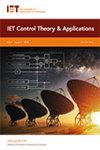带死区非齐次马尔可夫跳变系统的自适应神经异步控制
IF 2.2
4区 计算机科学
Q2 AUTOMATION & CONTROL SYSTEMS
引用次数: 0
摘要
本文研究了具有输入死区的非齐次马尔可夫跳变系统的自适应神经异步控制问题。利用两层非齐次马尔可夫过程精确表征时变转移概率。采用隐马尔可夫模型检测系统模式,解决控制器的异步问题。基于检测模式和神经网络策略,提出了一种自适应异步控制策略。利用李雅普诺夫稳定性理论证明了系统在该控制律下保持概率有界。最后,通过仿真实例验证了控制策略的有效性。本文章由计算机程序翻译,如有差异,请以英文原文为准。

Adaptive neural-based asynchronous control for nonhomogeneous Markov jumping systems with dead zones
This article addresses the challenge of adaptive neural-based asynchronous control for nonhomogeneous Markov jumping systems with input dead zones. Time-varying transition probabilities are precisely characterized using a two-layer nonhomogeneous Markov process. A hidden Markov model is employed to detect system modes and resolve the asynchronous issues of controllers. Based on the detected modes and a neural network strategy, an adaptive asynchronous control strategy is proposed. The Lyapunov stability theory is used to prove that the system remains probabilistically bounded under this control law. Finally, the effectiveness of the control strategy is demonstrated through a simulation example.
求助全文
通过发布文献求助,成功后即可免费获取论文全文。
去求助
来源期刊

IET Control Theory and Applications
工程技术-工程:电子与电气
CiteScore
5.70
自引率
7.70%
发文量
167
审稿时长
5.1 months
期刊介绍:
IET Control Theory & Applications is devoted to control systems in the broadest sense, covering new theoretical results and the applications of new and established control methods. Among the topics of interest are system modelling, identification and simulation, the analysis and design of control systems (including computer-aided design), and practical implementation. The scope encompasses technological, economic, physiological (biomedical) and other systems, including man-machine interfaces.
Most of the papers published deal with original work from industrial and government laboratories and universities, but subject reviews and tutorial expositions of current methods are welcomed. Correspondence discussing published papers is also welcomed.
Applications papers need not necessarily involve new theory. Papers which describe new realisations of established methods, or control techniques applied in a novel situation, or practical studies which compare various designs, would be of interest. Of particular value are theoretical papers which discuss the applicability of new work or applications which engender new theoretical applications.
 求助内容:
求助内容: 应助结果提醒方式:
应助结果提醒方式:


